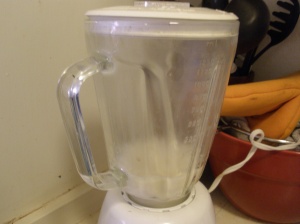What could it be, you ask? I realize I’m making quite a claim here. My answer? Oatmeal. Oatmeal is actually pretty fast when you cook it yourself instead of making it from the instant packets. Quick-cooking oats cook within 1 minute, regular “old fashioned” oats in 5, and, my favorite kind, steel-cut oats cook in about 15 minutes, or even more depending on how creamy you want them. However, many of us are not willing to cook anything in the morning. I know this because I hear it all the time from people I know. Below, see what steel cut oats look like if you’ve never seen them before. Steel cut oats are just the entire oat “groat” cut into smaller pieces, whereas more “mainstream” oats are whole oats that are steamed and then pressed, making them faster cooking and giving them a different texture.
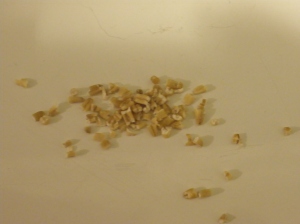
steel cut oats
Many people I know who don’t want to commit to cooking something for breakfast eat instant oatmeal. There’s nothing inherently wrong with eating instant oatmeal, but many brands have a lot of added sugar and other questionable ingredients. Others, like Kashi, are better in terms of having less sugar, but cost more. I checked, and a box of 6 packets of Kashi instant oatmeal are $3.50-$5, depending on where you buy it. If you cook your own oatmeal, it’s unbelievably cheap by comparison. For $4, I can get 4 pounds of steel cut oats from a local grocery store’s bulk food section. There are some brands of steel cut oats that are pricier, like McCann’s, but typically you can find them cheaply priced in the bulk section of many grocery stores. Also for $4, you can get two big canisters, or about 4 pounds total, of 1-minute quick or 5-minute old fashioned oats.
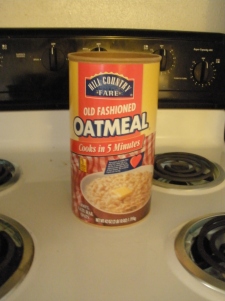
2 lb container of 5-minute oats (30 servings), also known as "old fashioned oats"
The solution that will help you save both time and money and reduce your sugar intake is the following: Make several servings on Sunday evening, store in the refrigerator, and reheat as needed throughout the week with a bit of extra water and your favorite toppings. I got this idea from Heidi Swanson, in her book Super Natural Cooking. You still have, in effect, an “instant” breakfast, but it won’t have as much sugar and it’s much cheaper. Plus, you can use some tasty and creative toppings. Here, I give you some ideas. But first, how to make the oatmeal. My example is with steel cut oats, because I prefer them. I enjoy the 5- minute “old fashioned” oats as well and buy them also, but I don’t really like the 1-minute “quick oats” because they come out a bit mushy, in my opinion. But, to each his own.
I made 4 servings of oatmeal, with 1 and 1/3 cups of oats, 4 cups of water, and 1/2 tsp of salt. Steel cut oats require a 1/3 cup oats to 1 cup water ratio, whereas 1-minute and 5-minute oats require a 1/2 cup of oats to 1 cup of water. Multiply these amounts based on how many servings you need to make. You need some salt to bring out the “oaty” flavor. When I forget to add salt, my oats are bland. No one wants bland oats. Anyway, each serving needs just a pinch of salt. For my 4 servings, I used a 1/2 tsp, so use that as a guideline if you need to multiply.
Step one is to measure out oats and water. Step two, bring water to a boil with the salt.
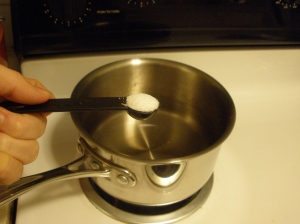
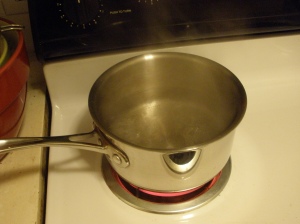
When water boils, add the oats. Stir, then turn down heat to medium low. Leave uncovered to cook for the time required depending on the type of oats you are cooking. Steel cut oats need at least 15 minutes. I cooked mine for 20 or so. Obviously, quick and 5-minute oats will cook much faster!

Simmering oats
The oats will thicken as they cook away….
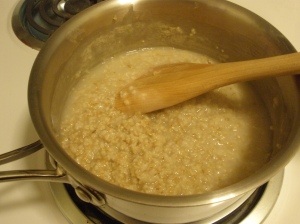
Once your oats are done cooking, allow them to cool a bit and transfer to a container for storing in the refrigerator. Refrigerate. When ready to eat, add a bit of extra water, perhaps 1 tablespoon per serving, and microwave for 1-2 minutes. Then, add your favorite toppings. More on that in a second…but first, pictures on what I did with my oatmeal this morning:
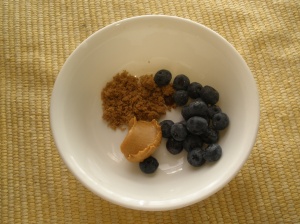
Blueberries, brown sugar, and peanut butter
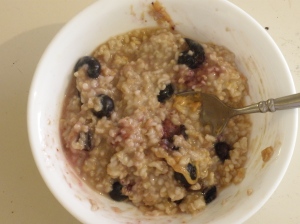
Yum!
To this, I added some soy milk. You can use soy milk, cow milk, cream, goat milk, almond milk, or no milk. Whatever you want.
So, with a bit of forethought and some oat cooking on Sunday evening, I have enough “instant” oatmeal to last several days.
One of the advantages of cooking up plain oatmeal is that you can play with different toppings and come up with some very tasty results. You pick your sweetener here, whether it be brown sugar, white sugar, honey, maple syrup, molasses, whatever. Unless you pour on the sugar, you’re certainly getting less sugar than you would with your average flavored instant oatmeal. Here is a list of some of my favorite combinations:
- 1 or 2 teaspoons peanut butter with a few chocolate chips. It’s fabulous. Like a cookie! My sister taught me this trick.
- berries, like blackberries or blueberries, with peanut butter and brown sugar
- frozen or fresh mango with some coconut and some brown sugar or honey
- walnuts, cinnamon, brown sugar
- fresh or frozen strawberries, mashed, and some brown sugar
- mashed banana with peanut butter
- chopped dates, brown sugar, and walnuts
- raisins or dried cranberries with walnuts or almonds
- whatever kind of jam you have
- applesauce
There are endless other combinations, but those are some favorites that come to mind. Enjoy your “instant” oatmeal!
Tags: Dried fruit, Oatmeal


